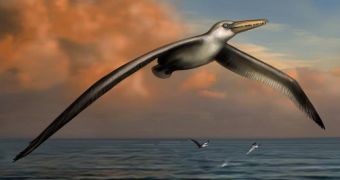A paper published in yesterday's issue of the journal Proceedings of the National Academy of Sciences documents the discovery of the fossilized remains of what is believed to be the largest bird ever to inhabit the Earth.
The creature in question is believed to have lived somewhere between 25 and 28 million years ago. Interestingly enough, it was only recently that the scientific community became aware this species ever existed.
Thus, it was back in 1983 that the fossilized remains of one such monstrous bird were unearthed near the city of Charleston in South Carolina, US, by construction workers entrusted with building a new terminal at local airport.
“The upper wing bone alone was longer than my arm,” explains researcher Dan Ksepka of the National Evolutionary Synthesis Center in Durham, North Carolina, looking to help folks understand just how big this creature was.
Shortly after being dug out, the bird's remains, i.e. wing and leg bones, and even a complete and surprisingly well-preserved skull, were taken to the Charleston Museum, Phys Org informs.
Scientists now say that, unless fossils belonging to some other, larger flying creature are discovered in the years to come, this species, dubbed Pelagornis sandersi, is to go down in history as the largest bird ever to inhabit the Earth.
As detailed in the journal Proceedings of the National Academy of Sciences, these ancient birds had an average wingspan of about 20 feet (roughly 6.1 meters). However, some specimens grew to have a wingspan of 24 feet (about 7.3 meters).
Interestingly enough, specialists say that, despite their impressive size, the birds had no trouble lifting themselves off the ground and that, when in the air, were surprisingly efficient gliders. This is because, size aside, their wings were fairly slender.
Given its size, it is highly unlikely that this bird species was able to get its body up in the air simply by flapping its wings from a standstill position, researchers who have had the chance to study its remains argue.
Information obtained with the help of computer models indicates that, in order to leave the ground, these birds first had to run downhill, looking to get some wind under their wings and thus manage to leave the ground.
Pelagornis sandersi is believed to have relied on air currents rising from the ocean's surface to navigate its environment and go in search of food. More precisely, researchers say that, when hungry, it simply went flying over bodies of water, looking to catch prey similar to squid and eels.

 14 DAY TRIAL //
14 DAY TRIAL //